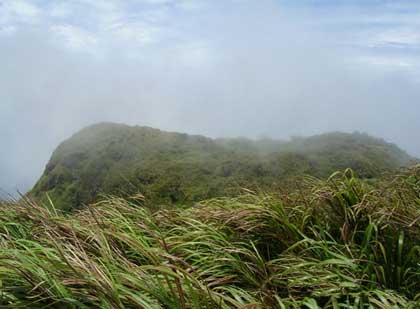

| the expedition | |
| the science | |
| tools & techniques | |
| marianas history | |
| daily journal | |
| the team | |
| questions & answers | |
|
the islands Saipan Anatahan Sarigan Guguan Alamagan Pagan Agrigan Asuncion Maug Uracas |
|
|||||||||||||||||||||||||||||||||||||||||||||||||||||||||||||||
Daily Journal
Day 7 | April 15, 2004
Sarigan Volcano
Dave Hilton's Log | Lillie Jaffe's Log
David, Alison and Toby left Saipan on Thursday morning by helicopter and headed by air to Sarigan, our first sampling target. Since there are no reports of geothermal activity on the island, the main goal at this site was to sample lava flows and tephra deposits (ash and scoria).
The peaks of Sarigan consist of altered andesitic lava blocks and are completely covered by swordgrass. The extent of vegetation made the hike to the peaks very difficult and we had to use a machete to cut a path through the grass which was often above our heads. It is not known when the last eruption of Sarigan occurred, but judging by the degree of vegetation and the extent of alteration of the rocks, it was likely in pre-historic times.
The steep flanks of Sarigan are made up of several layers of pyroclastic material (i.e. rocks ejected explosively from the volcano). This photo shows a dark ash unit at the base of the section, overlain by a light-colored pumice layer and a debris flow at the top. Debris flows consist of a mixture of water and poorly-sorted rock material: they can travel downslope, following the topography, at speeds up to ~60 km/h. We sampled the lower ash unit. In addition, we sampled a scoria layer from below the ash. Both of these units contained olivine, a mineral which effectively traps magmatic volatiles - ideal for He isotope analyses and melt inclusion studies. After a grueling first day of sampling, we were happy to finally make it back to our campsite.
Lillie Jaffe | Life on the R/V Wecoma
Erik, Maarten, Jenn, and I (Lillie) are well underway on our 10-day ship voyage around the Mariana Islands. Prior to our landing at Guguan tomorrow (Friday 16, April), the ship is picking up Ocean Bottom Seismomometers (OBS) that were dropped onto the seafloor about a year ago. A team of geophysicists/seismologists (Doug Wiens, Patrick Shore and Sara Pozgay of Washington University, Allan Sauter of Scripps Institution of Oceanography, Hiroko Sugioka from JAMSTEC, and Hajime Shiobara from University of Tokyo) are using the Wecoma to retrieve the ocean-bottom instruments as well as to access the various islands to dismantle a series of land-based stations. See the interview with Doug Wiens to learn more about OBSs and what they can tell us about the Marianas subduction zone.
 In the meantime, the volcanology team eagerly awaits our arrival on Guguan. The boat trip has been pretty rough—a nearby
hurricane has created 10-ft swells that cause the ship to sway in motions that are not always pleasing to
weak-stomached passengers such as myself. Walking in a straight line is a bit of a challenge, and it is impossible to go out
on deck without getting soaked, which is somewhat enjoyable in the tropical climate. We entertain ourselves by reading,
watching movies in the lounge, catching up on missed school work, and chatting with the Wecoma crew. It's a nice break before
our arduous task ahead-trekking the overgrown jungles of these uninhabited islands, in search of gas and rock
samples that will hopefully answer our scientific questions about mass balance and the "Ins and Outs" of subduction zones.
In the meantime, the volcanology team eagerly awaits our arrival on Guguan. The boat trip has been pretty rough—a nearby
hurricane has created 10-ft swells that cause the ship to sway in motions that are not always pleasing to
weak-stomached passengers such as myself. Walking in a straight line is a bit of a challenge, and it is impossible to go out
on deck without getting soaked, which is somewhat enjoyable in the tropical climate. We entertain ourselves by reading,
watching movies in the lounge, catching up on missed school work, and chatting with the Wecoma crew. It's a nice break before
our arduous task ahead-trekking the overgrown jungles of these uninhabited islands, in search of gas and rock
samples that will hopefully answer our scientific questions about mass balance and the "Ins and Outs" of subduction zones.
 Maarten also interviews Joe Kaipat from the Emergency Management Office on Saipan who is
accompanying our group on the expedition. Based on Joe's childhood experience when he was evacuated from Pagan after
the volcano exploded, they discuss what it was like to live through a volcanic erruption.
Maarten also interviews Joe Kaipat from the Emergency Management Office on Saipan who is
accompanying our group on the expedition. Based on Joe's childhood experience when he was evacuated from Pagan after
the volcano exploded, they discuss what it was like to live through a volcanic erruption.




